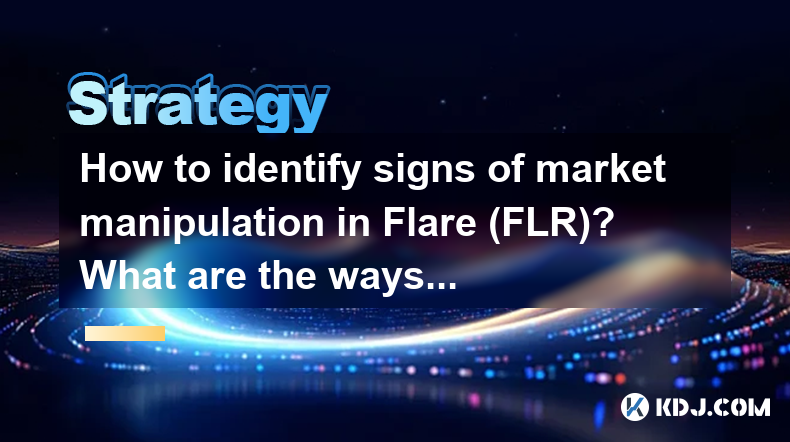-
 bitcoin
bitcoin $121833.232455 USD
-0.63% -
 ethereum
ethereum $4394.437030 USD
-2.00% -
 tether
tether $1.000570 USD
0.04% -
 bnb
bnb $1255.553465 USD
-3.73% -
 xrp
xrp $2.814944 USD
-1.59% -
 solana
solana $221.835346 USD
-2.40% -
 usd-coin
usd-coin $0.999869 USD
0.01% -
 dogecoin
dogecoin $0.249495 USD
-1.32% -
 tron
tron $0.336905 USD
-1.24% -
 cardano
cardano $0.816464 USD
-1.69% -
 chainlink
chainlink $22.130946 USD
-1.27% -
 hyperliquid
hyperliquid $44.208522 USD
-3.46% -
 ethena-usde
ethena-usde $1.000521 USD
0.02% -
 sui
sui $3.422897 USD
-2.51% -
 stellar
stellar $0.380164 USD
-1.31%
How to identify signs of market manipulation in Flare (FLR)? What are the ways to avoid being trapped?
To avoid market manipulation in Flare (FLR), conduct thorough research, use technical analysis, monitor social media, set stop-loss orders, and diversify your portfolio.
May 04, 2025 at 11:07 pm

Understanding Market Manipulation in Flare (FLR)
Market manipulation in the cryptocurrency space, including with Flare (FLR), refers to the deliberate attempt to interfere with the free and fair operation of the market, often to create artificial price movements. Identifying these signs is crucial for any investor looking to protect their investments. In this article, we will explore the various signs of market manipulation specific to Flare (FLR) and discuss strategies to avoid falling into these traps.
Signs of Market Manipulation in Flare (FLR)
Pump and Dump Schemes
Pump and dump schemes are one of the most common forms of market manipulation in the crypto world. In the context of Flare (FLR), this involves artificially inflating the price of the token through coordinated buying and spreading of positive rumors, only to sell off the holdings at the peak, leaving other investors with losses.
- Sudden Price Spikes: Look for unexplained and rapid increases in the price of FLR, especially if they are not backed by any significant news or developments.
- High Volume Trading: Unusually high trading volumes in a short period can indicate a coordinated effort to pump the price.
- Social Media Hype: An influx of positive posts and endorsements on social media platforms about FLR can be a red flag, especially if they seem coordinated or overly enthusiastic.
Wash Trading
Wash trading involves an individual or group trading with themselves to create the illusion of market activity. This can be particularly deceptive in the Flare (FLR) market.
- Consistent Trading Patterns: If you notice consistent buy and sell orders at similar price points, it might be a sign of wash trading.
- No Price Movement: Despite high trading volumes, if the price of FLR remains relatively stable, it could indicate wash trading.
Spoofing
Spoofing is another tactic where traders place large orders to influence the market without intending to execute them. In the Flare (FLR) market, this can lead to false signals about market demand.
- Large Orders that Disappear: If you see large buy or sell orders that appear and disappear without being filled, it could be a sign of spoofing.
- Price Fluctuations: Sudden price movements followed by a return to the original price can indicate spoofing attempts.
FUD (Fear, Uncertainty, and Doubt)
FUD is a tactic used to spread negative information about Flare (FLR) to drive down its price, allowing manipulators to buy at a lower price.
- Negative News without Substance: Be wary of negative news or rumors that lack credible sources or evidence.
- Sudden Price Drops: Unexplained and rapid price drops in FLR can be a result of FUD campaigns.
Ways to Avoid Being Trapped in Flare (FLR) Market Manipulation
Conduct Thorough Research
Before investing in Flare (FLR), conduct thorough research on the project, its team, and its developments. This can help you distinguish between genuine growth and manipulated price movements.
- Verify Information: Always cross-check information from multiple reputable sources.
- Understand the Project: Gain a deep understanding of Flare's technology, roadmap, and market position.
Use Technical Analysis
Technical analysis can help you identify potential manipulation by analyzing price charts and trading volumes.
- Identify Patterns: Look for unusual patterns in the price and volume charts of FLR.
- Use Indicators: Utilize technical indicators like the Relative Strength Index (RSI) and Moving Averages to spot anomalies.
Monitor Social Media and Forums
Social media and forums are often used to spread manipulative information. Monitoring these platforms can help you stay ahead of potential manipulation.
- Follow Reputable Sources: Stick to reputable sources and avoid following unverified accounts.
- Analyze Sentiment: Use sentiment analysis tools to gauge the overall sentiment around Flare (FLR).
Set Stop-Loss Orders
Stop-loss orders can help you limit potential losses from market manipulation.
- Determine Stop-Loss Levels: Set stop-loss orders at levels that you are comfortable with, based on your risk tolerance.
- Monitor and Adjust: Regularly monitor and adjust your stop-loss orders to reflect current market conditions.
Diversify Your Portfolio
Diversifying your portfolio can reduce the impact of market manipulation on your overall investment.
- Invest in Multiple Assets: Spread your investments across different cryptocurrencies to mitigate risk.
- Balance Risk and Reward: Ensure your portfolio is balanced between high-risk and low-risk assets.
Frequently Asked Questions
Q: Can market manipulation be completely avoided in the Flare (FLR) market?A: While it's impossible to completely avoid market manipulation, being vigilant and using the strategies outlined above can significantly reduce your risk of falling victim to such schemes.
Q: How can I report suspected market manipulation in Flare (FLR)?A: If you suspect market manipulation, you can report it to the relevant regulatory bodies or the exchange where FLR is traded. Many exchanges have mechanisms in place to investigate and address such concerns.
Q: Are there any tools specifically designed to detect market manipulation in Flare (FLR)?A: While there are no tools specifically designed for Flare (FLR), general market analysis tools like TradingView and Coinigy can help you monitor price movements and trading volumes to identify potential manipulation.
Q: How does the Flare (FLR) community address market manipulation?A: The Flare (FLR) community often uses social media and forums to raise awareness about potential manipulation. Community members may also collaborate with developers and exchanges to report and address these issues.
Disclaimer:info@kdj.com
The information provided is not trading advice. kdj.com does not assume any responsibility for any investments made based on the information provided in this article. Cryptocurrencies are highly volatile and it is highly recommended that you invest with caution after thorough research!
If you believe that the content used on this website infringes your copyright, please contact us immediately (info@kdj.com) and we will delete it promptly.
- Starknet (STRK) Price Pumping: What's Behind the Surge?
- 2025-10-10 22:45:15
- Dogecoin, Bitcoin, and Chart Analysis: Navigating the Crypto Seas
- 2025-10-10 22:45:15
- Crypto, Bitcoin, Buy Now: Navigating the Current Landscape
- 2025-10-10 22:50:01
- Meme Coin Mania: Is Layer Brett the New Dogecoin?
- 2025-10-10 22:50:01
- Ozak AI Crypto Presale: Hitting Funding Targets and Redefining AI on the Blockchain
- 2025-10-10 22:25:15
- Changpeng Zhao, AsterLiquid, and Allegations: Decoding the Crypto Drama
- 2025-10-10 22:25:15
Related knowledge

Practical parameter settings for a Bitcoin multi-timeframe moving average system
Sep 18,2025 at 10:54pm
Optimizing Timeframe Combinations for Bitcoin Trading1. Selecting appropriate timeframes is crucial when building a multi-timeframe moving average sys...

How can I filter out false breakouts in Dogecoin high-frequency trading?
Sep 22,2025 at 01:00am
Understanding False Breakouts in Dogecoin Trading1. A false breakout occurs when Dogecoin's price appears to move beyond a defined support or resistan...

Techniques for identifying tops and bottoms in the Bitcoin on-chain NVT model
Sep 20,2025 at 07:54pm
Understanding the NVT Model in Bitcoin Analysis1. The Network Value to Transactions (NVT) ratio is often described as the 'P/E ratio' of the cryptocur...

What does the surge in open interest in Bitcoincoin futures mean?
Sep 20,2025 at 11:18pm
Understanding the Surge in Dogecoin Futures Open Interest1. A surge in open interest within Dogecoin futures indicates a growing number of active cont...

How can I use the Ethereum USDT premium to gauge market sentiment?
Sep 18,2025 at 11:55pm
Understanding the Ethereum USDT Premium1. The Ethereum USDT premium refers to the price difference between USDT (Tether) traded on Ethereum-based plat...

What should I do if Ethereum staking yields decline?
Sep 20,2025 at 06:18am
Understanding the Causes Behind Declining Ethereum Staking Yields1. The Ethereum network transitioned to a proof-of-stake consensus mechanism with the...

Practical parameter settings for a Bitcoin multi-timeframe moving average system
Sep 18,2025 at 10:54pm
Optimizing Timeframe Combinations for Bitcoin Trading1. Selecting appropriate timeframes is crucial when building a multi-timeframe moving average sys...

How can I filter out false breakouts in Dogecoin high-frequency trading?
Sep 22,2025 at 01:00am
Understanding False Breakouts in Dogecoin Trading1. A false breakout occurs when Dogecoin's price appears to move beyond a defined support or resistan...

Techniques for identifying tops and bottoms in the Bitcoin on-chain NVT model
Sep 20,2025 at 07:54pm
Understanding the NVT Model in Bitcoin Analysis1. The Network Value to Transactions (NVT) ratio is often described as the 'P/E ratio' of the cryptocur...

What does the surge in open interest in Bitcoincoin futures mean?
Sep 20,2025 at 11:18pm
Understanding the Surge in Dogecoin Futures Open Interest1. A surge in open interest within Dogecoin futures indicates a growing number of active cont...

How can I use the Ethereum USDT premium to gauge market sentiment?
Sep 18,2025 at 11:55pm
Understanding the Ethereum USDT Premium1. The Ethereum USDT premium refers to the price difference between USDT (Tether) traded on Ethereum-based plat...

What should I do if Ethereum staking yields decline?
Sep 20,2025 at 06:18am
Understanding the Causes Behind Declining Ethereum Staking Yields1. The Ethereum network transitioned to a proof-of-stake consensus mechanism with the...
See all articles










































































